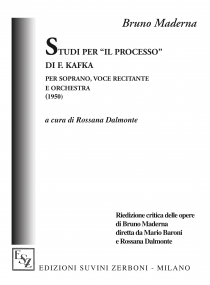Specifications
Region
Europe
Estimated Duration
11 - 15min
Date
2000
ISMN : 979-0-2325-0168-0
In Stock
Notes on this piece Gehen means “walking” in German, and it is the gesture of walking that forms the basis of this piece. Time and again, islands of instruments crop up in various combinations only to vanish into nothingness. The soprano and baritone reinforce the realms of associations by adding words from the material Klein has chosen to work with: an imagist poem of her own devising that translates roughly as follows:
walking.does it raise dust?a bomb craterpass through-through-through-through-through-throughare the ladies (walking) in white?one leg is deaf. pass throughbite blind leaves no. pass throughdoes it raise dust?stone and fieldgrey green yellow green yellow white light-brown green beige greypale green grey brown yellow beige pale bright-white gentle greenbeige grey green bright-white pale gentle green grey brown grey yellow white beige grey yellow green pale beige brown grey yellowDoes snow lie on the ponds of the Tuileries?Does snow lie on the ponds of the Tuileries?Dissonant images arise in the listener’s mind: romantic impressions of Paris and the Tuileries are briefly suggested by the choice of accordion; the danger of bomb craters resonates in the timpani. Klein deliberately sets these associations in order to prolong the resultant images with quite different means, to elevate them from the specific to a more abstract plane.The initial sketches of this piece for soprano, baritone, and instrumental ensembles were made in pencil: round figures arising from broken lines on white A3 paper. Having delineated these areas, Klein then wrote notes for various combinations of instruments inside them. As she explains, “The mental representation of music – the things that exist prior to the score, the thoughts and deliberations – cannot be captures in five-line staves ruled into bars on A4 paper. That is only our European way of writing down music. Thoughts work in a different way; they are more complex, richer, with unlimited possibilities.”Looking at the sketch, we immediately notice connections: we realize that blank areas are not simply “empty”, and that consequently neither are the rests in the fully executed score – that is, in the conventional musical notation. The task the musicians have to face is not only to play their own parts, but always to memorize the entire piece in all its facets, and to define their position precisely by striking a balance with the others and with the piece as a whole. Only in this way will the aspect of walking take on a dramaturgical shape.
This score is published by Edition Juliane Klein publishing house. You can read the full score online through our Subscription service.
For buying or hiring the score please contact Edition Juliane Klein.
Edition Juliane Klein Collection at BabelScores
Add to a playlist
- Login to create your own lists
walking.does it raise dust?a bomb craterpass through-through-through-through-through-throughare the ladies (walking) in white?one leg is deaf. pass throughbite blind leaves no. pass throughdoes it raise dust?stone and fieldgrey green yellow green yellow white light-brown green beige greypale green grey brown yellow beige pale bright-white gentle greenbeige grey green bright-white pale gentle green grey brown grey yellow white beige grey yellow green pale beige brown grey yellowDoes snow lie on the ponds of the Tuileries?Does snow lie on the ponds of the Tuileries?Dissonant images arise in the listener’s mind: romantic impressions of Paris and the Tuileries are briefly suggested by the choice of accordion; the danger of bomb craters resonates in the timpani. Klein deliberately sets these associations in order to prolong the resultant images with quite different means, to elevate them from the specific to a more abstract plane.The initial sketches of this piece for soprano, baritone, and instrumental ensembles were made in pencil: round figures arising from broken lines on white A3 paper. Having delineated these areas, Klein then wrote notes for various combinations of instruments inside them. As she explains, “The mental representation of music – the things that exist prior to the score, the thoughts and deliberations – cannot be captures in five-line staves ruled into bars on A4 paper. That is only our European way of writing down music. Thoughts work in a different way; they are more complex, richer, with unlimited possibilities.”Looking at the sketch, we immediately notice connections: we realize that blank areas are not simply “empty”, and that consequently neither are the rests in the fully executed score – that is, in the conventional musical notation. The task the musicians have to face is not only to play their own parts, but always to memorize the entire piece in all its facets, and to define their position precisely by striking a balance with the others and with the piece as a whole. Only in this way will the aspect of walking take on a dramaturgical shape.
This score is published by Edition Juliane Klein publishing house. You can read the full score online through our Subscription service.
For buying or hiring the score please contact Edition Juliane Klein.
Edition Juliane Klein Collection at BabelScores
Instrumentation
Soprano voice|Baritone voice|Flute|oboe|Clarinet|trumpet|trombone|Percussions|Violin (2)|Viola|Cello|double bass|
Score Details
Format - A4 / US Letter
Pages - 43
Pages - 43








